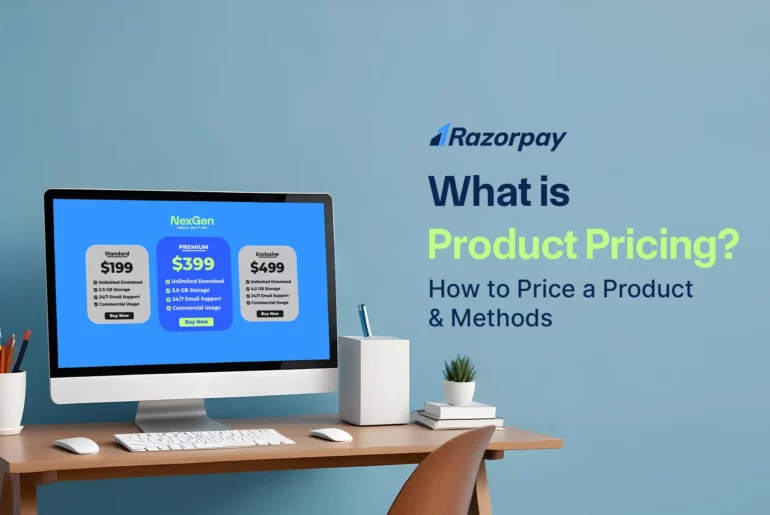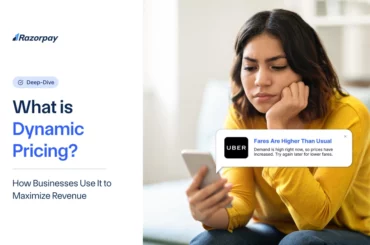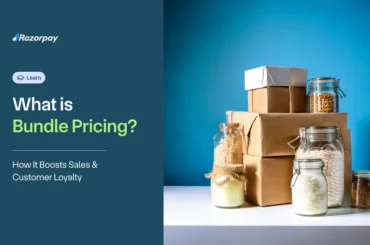Product pricing is setting the monetary value or cost for a product or service to achieve business objectives, such as profit maximization, capturing market share, etc. This guide explores the fundamentals of product pricing, discusses pricing methods, factors to consider, and more to highlight pricing significance in business operations.
Table of Contents
What Is Product Pricing?
Product pricing refers to deciding how much to charge for a product or service and plays a crucial role in influencing consumer behavior and determining company profitability. It involves considering costs, competition, and what customers are willing to pay. Pricing can affect sales and profits, so businesses must balance setting a price that covers expenses while appealing to customers.
Understanding Product Pricing Strategy With an Example
Let’s consider an example: a premium coffee brand introducing a new blend. The company analyses its production costs, competitor pricing, and consumer preferences. They position the coffee as a high-quality, ethically sourced product. Based on this, they set a premium price that reflects both the cost and the perceived value.
This strategy aims to attract discerning coffee enthusiasts willing to pay more for exceptional quality.
Factors to Consider When Pricing a Product
1) Cost Analysis
A cost analysis thoroughly reviews the direct and indirect costs that determine the final pricing of a product or service. It includes factors like production costs, labor, overhead, and more. This analysis helps identify significant cost variations and enables you to negotiate fair pricing with suppliers.
2) Target Market
Your target market is defined by the group of consumers, based on age, gender, location, socioeconomic status, and other criteria, to whom your products and marketing are targeted. Understanding who your customers are and what they desire helps you determine what product price they are ready to pay.
3) Competitive Landscape
This concept refers to a customer’s list of options rather than your product. By identifying direct and indirect competitors, you learn about the competitive edge of your products. Consider your competitors’ target-audience preferences, product features, and pricing strategies when making pricing decisions.
4) Brand Positioning
It is the strategy used to set your business apart from the rest. When products are expensive because of their quality and exclusivity, and the brand highlights these aspects, customers see the cost as justified.
5) Product Value
The overall value of a product is determined by how well it meets or surpasses customers’ expectations. This value influences both product design and pricing strategy. Companies use product value to prioritize improvements and enhance targeting and brand messaging.
6) Market Demand
Market demand is the total amount of a product or service customers are happy to purchase at a particular price in a specific market. Demand-based pricing, or dynamic pricing, is a strategy where the current level of demand determines the price.
Product Pricing Methods
1) Value-based Pricing
This model revolves around the consumer’s perceived value of a product or service. The company sets prices based on how much the customer believes the product is worth, especially effective for unique or high-value offerings.
Industries or products where this pricing model is used include:
-
Pharmaceuticals: Medicines are priced higher due to necessity and perceived essential value.
-
Fashion: Items are priced based on the brand’s perceived value or emotional appeal.
-
Shortages: Prices rise during shortages, such as drinks at a summer festival, due to increased perceived value.
2) Competitive Pricing
Competitive pricing is a strategy where businesses set their prices in line with or lower than their competitors. This approach is often used in industries selling similar products, helping new market entrants find the optimal pricing for their offerings.
Examples of industries or products using competitive pricing:
-
CRM Software Industry: Companies like Salesforce and Microsoft Dynamics frequently review each other’s pricing to stay competitive.
-
E-commerce Marketplaces: Platforms like Amazon use pricing algorithms to maintain competitive prices.
-
Retail Industry: Online retail prices often fluctuate due to the high sales volumes of similar products.
3) Cost-plus Pricing
This pricing model calculates the product’s selling price by adding a specific markup to the unit cost which includes direct costs, like raw materials and labor, and indirect costs, like overhead. The markup (fixed percentage) describes the expected profit margin. This method excludes external factors like customer demand and competitor prices.
Examples of industries using cost-plus pricing include construction industries for large projects, some retail stores to cover costs and ensure profitability, and custom manufacturing.
Cost-plus pricing is suitable in scenarios where:
-
The product is unique or high-quality, and customers are willing to pay a premium.
-
The business has a loyal customer base that is not sensitive to price changes.
-
The business operates in a stable or regulated market with predictable costs and demand.
4) Dynamic Pricing
Dynamic pricing is a responsive pricing strategy that adapts in real time based on fluctuations in demand and supply, competitor prices, and inventory levels to set optimal prices.
The following industries frequently use dynamic pricing:
-
Airlines: Airlines adjust ticket prices based on seat type, number of remaining seats, and time until the flight.
-
Hospitality: Hotels and other hospitality businesses adjust their room rates based on occupancy rates, time of booking, and season.
-
Ride-sharing: Companies like Uber adjust their fares based on time, distance, traffic, peak hours, and current rider-to-driver demand.
5) Price Skimming
Price skimming refers to a strategy where businesses initially set a high price for a product and gradually lower it over time. This strategy targets early adopters and is often effective when the business has a powerful brand and customer base, the product or service is new or revolutionary, and there are no competitors. However, it doesn’t target the wider market initially and can alienate price-sensitive customers.
This product pricing model is common in the technology, automotive, and fashion sectors. For example, tech leaders Apple and Samsung may begin with a premium price and then gradually reduce it to appeal to more price-conscious consumers.
6) Penetration Pricing
Penetration pricing is a method where businesses set a low initial price to capture the customers’ interest and rapidly gain market share. New market entrants often favor this approach.
Adopting this approach benefits companies through rapid customer adoption and potential market leadership. However, fostering customer loyalty is challenging and may necessitate price increases for business expansion.
Examples of penetration pricing can be observed in sectors such as streaming services, internet providers, and smartphone manufacturers. These companies initially offer reduced prices or free trials to draw in customers and establish a competitive position.
7) Promotional Pricing
Promotional pricing is a strategy where the price of a product or service is temporarily reduced to attract customers and boost sales. This tactic can effectively drive short-term sales, clear inventory, introduce new products, and generate excitement.
Typical promotional pricing strategies include:
-
Flash Sales: Brief, time-limited promotions that create urgency and prompt quick purchases.
-
Seasonal Discounts: Special pricing is offered during holidays or at the end of seasons.
-
Loyalty Program Discounts: Exclusive offers or discounts for returning customers.
-
Clearance Sales: Reduced prices aimed at clearing out outdated or surplus stock.
-
Introductory Pricing: Lower prices for newly launched products or services to encourage initial trial and adoption.
These methods are commonly employed in retail and e-commerce sectors, significantly impacting sales volumes, revenue growth, and cash flow.
8) Freemium Pricing
Freemium pricing is a strategy where a basic version of a product or service is offered free of charge while premium features are available for a fee. This approach can attract users and convert their interest into revenue.
Companies benefit from freemium pricing through rapid user base expansion, leveraging virality, and maintaining low sales and marketing expenses. However, this approach is not without challenges. Keeping a balance between free and premium offerings and managing costs associated with non-paying users becomes difficult for the company.
Successful freemium models include software applications like Dropbox and online platforms like LinkedIn.
9) Bundle Pricing
Bundle pricing combines separate products at a single, often discounted, price, leveraging the idea of ‘consumer surplus,’ where customers have a perceived value they are willing to pay for bundled items. This strategy is popular in e-commerce and among service providers for promoting particular products and increasing sales volume.
Here are a few examples of successful bundle pricing strategies:
-
Tech companies: Adobe offers software packages, providing customers with a collection of tools at a bundled price.
-
Telecommunication companies: They often offer bundled services, including internet, TV, and phone services.
-
Retailers: Both physical and online, frequently sell themed bundles, like a beauty care package or a DIY toolkit.
10) Psychological Pricing
Psychological pricing is a strategy that uses consumers’ emotional responses to price points. Standard techniques include setting prices just below round numbers (e.g., ₹999 instead of ₹1,000) to make the price seem lower and using “prestige pricing” for luxury items to signal quality.
These methods exploit consumer perception, making products appear more attractive or affordable without significant cost differences.
Examples of industries using psychological pricing include retail, where prices often end at .99 or .95, and the travel industry, where package deals are usually offered at prices like ₹499 instead of ₹500.
How to Price a Product?
1. Calculate Costs as Per Product
To accurately price your products, you need to calculate the costs associated with each product in this manner:
-
Material Costs: Calculate the cost of all the raw materials used in the production of each unit.
-
Packaging Costs: Include the cost of packaging materials and the labor involved.
-
Employee Labour: Calculate the wages paid to employees directly involved in the production.
-
Sales Commissions: If you pay commissions to your sales team, include these costs.
-
Overhead Costs: These are indirect costs such as rent, utilities, and maintenance.
The formula to calculate the product cost is:
Product Cost = Direct Material Cost + Direct Labour Cost + Overhead Cost
2. Analysing Market Demand
Analyzing market demand involves understanding consumer preferences and purchasing power. Recognizing your distinctive selling points and evaluating them against your rivals is vital. This helps to carve a distinct space in the market.
To analyze current demand, you can conduct market research such as surveys, personal interviews, customer observation, and reviews of secondary research. You may also deploy modern analytics and research tools, allowing businesses to capture deeper insights from online reviews, social media, and customer interactions.
3. Identifying the Target Audience
Understanding your target audience involves considering their demographics (such as age, gender, and occupation), psychographics (their interests, attitudes, and values), and behaviors.
For instance, if you are selling organic pet food, your target audience might be middle-aged pet owners with disposable income who value sustainability. You can verify this by surveying your target market to gauge what they would pay for a service like yours and how much they currently spend on comparable services.
4. Assessing Market Prices
Analyze the prices of your competitors and market benchmarks. You can do this by researching the market and competitors, understanding the larger market you are competing against, and pricing your product competitively.
Additionally, external factors such as changes in the economy, shifts in consumer demand, and fluctuations in the cost of production can significantly impact market prices.
5. Incorporating Profit Margin
You must determine each item or service’s target markup or profit percentage to integrate a profit margin into your pricing strategy. This number is vital as it significantly influences the company’s earnings. It’s critical to find a balance between this margin and market competitiveness: overly high prices may drive away customers, but too low prices could undermine profits.
6. Setting and Monitoring Prices
Setting prices means choosing the right starting prices for what you are selling and then regularly checking to ensure they are still right for the market. It’s important to stay responsive and quickly adapt to market changes by observing what customers want, what competitors are doing, and the overall economy.
Technology to Manage Product Pricing
Technology is crucial in overseeing product pricing in the digital transformation era. Advanced tools and software solutions can help you analyze market trends and adjust prices in real-time to stay ahead of your competitors.
Pricing Engine
It is a software tool businesses utilize to automate or compute accurate and optimal prices for products and services based on defined criteria. It assists in maximizing profits by assessing diverse internal and external factors to pinpoint prices with the highest performance potential.
Pricing engines are commonly used in e-commerce, retail, hospitality, and travel industries.
Pricing Software
It helps businesses set, analyze, and optimize their product prices using advanced methods to analyze large volumes of historical data and swiftly offer optimal price recommendations.
Some of the key features of the software include real-time market analysis, dynamic price adjustments, and competitive pricing insights, etc. Using this software, businesses can improve their profitability and respond quickly to changes in the market, leading to increased sales and customer value.
Enterprise Resource Planning (ERP)
ERP systems play a crucial role in managing and integrating various pricing aspects within an organization by providing a centralized platform for the collection of data and analysis, offering a holistic view of business operations which helps in informed decision-making.
The integration of ERP systems with pricing strategies demonstrates their capability to optimize prices in real-time, leveraging insights from market trends, customer behavior, and cost dynamics to enable agile and effective pricing adjustments.
Configure Price Quote (CPQ)
CPQ (Configure, Price, Quote) is a sales automation tool that streamlines the creation of precise, tailored quotes for orders, seamlessly integrating with CRM systems and other business technologies to ensure data integrity and precision.
CPQ enhances sales efficiency by generating quotes faster, slashing approval times, and doubling the speed from quote to cash. This efficiency empowers sales representatives to concentrate more on selling and less on administrative duties.
Common Mistakes to Avoid in Product Pricing
-
Pricing too high or too low: Adjust prices carefully to avoid deterring customers or undermining product value.
-
Ignoring market trends: Stay updated with market shifts to align pricing with customer expectations and competitive benchmarks.
-
Failing to reassess regularly: Regularly review pricing strategies to adapt to changes in cost, competition, and customer demand.
-
Not segmenting customers: Tailor pricing strategies to different customer segments based on their sensitivity and willingness to pay.
Frequently Asked Questions (FAQs)
1. What are the four main products’ pricing?
The four main product pricing methods are Cost-plus pricing, where prices are set by adding a profit margin to the cost of production; Competitor-based pricing, where prices are determined based on competitors’ prices; Value-based pricing, where prices are set based on the perceived value to the customer; and Demand-based pricing, where prices are set based on market demand.
2. Can a business use more than one pricing method?
Yes, a business can use more than one pricing method. The choice of pricing method can depend on the product, target audience, competition, and the company’s objectives.
3. How often should a business reassess its pricing strategy?
As economic and competitive landscapes evolve, businesses should continually monitor and adapt their pricing strategy.
4. Why is product pricing important?
Product pricing is crucial as it directly impacts the revenue generated by sales. Appropriate pricing ensures profitability, balancing production, marketing, and other expenses. It also influences customer perception and market demand.
5. What are some common mistakes businesses make when pricing products?
Common pricing mistakes include basing prices solely on undercutting competition, not segmenting customers, not trying enough price points, overcomplicating pricing presentation and not updating prices regularly.
6. How does product pricing affect marketing strategies?
Product pricing has a direct impact on marketing strategies. It affects demand, sales volume, and profit margins. It also influences the product’s perceived value and the company’s competitive position in the market.
7. Can a business use a combination of different pricing methods?
Yes, a business can use a combination of different pricing methods. The choice of pricing methods can be tailored to the company’s goals, market conditions, and competitive environment.





